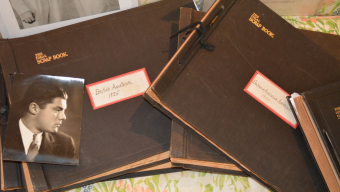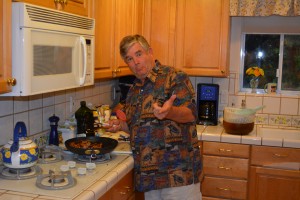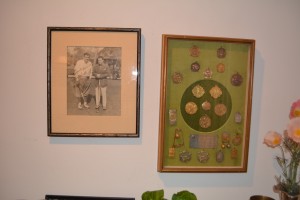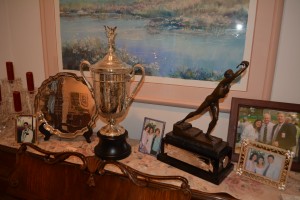(Editor’s Note: One of the great golf families in America lost a vital member Monday when Lawson Little III died in Las Vegas. He was competing in the World Series of Poker. Lawson was briefly on PGA Tour, was the golf professional/president at Quail Lodge in Carmel Valley, Ca., for more than 30 years and the son of five-time major champion, Lawson Little II, who won the 1940 U.S. Open at Canterbury CC in Cleveland, Ohio, 70 years ago this month. Lawson III was also a friend and one of the most gentle, generous and gracious individuals you could ever meet. Here is a story I did with Lawson last winter, talking about his love for his Hall of Fame father, who was somewhat overlooked in the panoply of golf history).
CARMEL VALLEY, Ca. – As we move into 2015, those in charge of American professional golf are anguishing over how to restore and revitalize the U.S. Ryder Cup team to prevent it from being swamped by the Europeans every two years.
A short-sighted system supposedly has been reason why the U.S. has lost eight of the last 10 Cup competitions, including a 16 1/2-11 ½ rout in 2014. Attitudes have been blamed. Excuses have been made, such as the top American players aren’t being selected or that Europeans are better suited for the format.
The result has been back-stabbing comments and grousing among the players and coaches. As a result, the PGA of America has formed a 11-member committee to seek solutions.
For me, the answer is simple. Just find more players with the skills and attitude once possessed by Lawson Little, Jr., one of the greatest ass-kicking match play players the game has ever known.
Little, who rose to prominence in the 1930s Golden Era of golf, was what Ian Poulter is now to the Europeans, an irrepressible, unbeatable force. Entering a match, Little was an intimidator, much like Tiger Woods was in his prime, and over two-year period from 1934 to 1935, all he did was win.
I recently spent some time with his son, Lawson Little III, at the family home in Carmel Valley. His son had an interesting golf life of his own, spending a brief time on the PGA Tour but primarily serving as head pro and President of Quail Lodge Resort for more than 36 years before retiring more than a year ago.
His son is the primary promoter for the golf exploits of his father, who, despite being elected to the World Golf Hall of Fame, is one of the most unknown and under appreciated major figures in golf of the 20th Century. His dad’s career was restricted by a series of bad breaks and unfortunate rules that prevented his career from soaring.
The accompanying story, Greatest Match Play Golfer Ever?, details some of what Little accomplished. After graduating from Stanford in 1934, Lawson immediately established his career highlights with back-to-back “Little Slams,” winning both the British Amateur and U.S. Amateur in both 1934 and 1935. Back then, amateur golf events carried more prestige that professional events and no one could touch Little during that period. He won an unprecedented 32 consecutive matches.
Little’s 14-and-13 victory over Jack Wallace in the 1934 British Amateur at Prestwick remains the largest margin of victory in a championship match in the event. One British sportswriter called it, “one of the most terrific exhibitions in all golfing history.”
Then later that summer at The Country Club in Brookline, Mass., he downed David Goldman, 8-and-7 in the U.S. Amateur title match.
He just kept rolling in 1935, defeating Bill Tweddell, 1-up, at Royal Lytham and St. Annes to win the British Am again. Then he beat Walter Emery, 4-and-2, at The Country Club in Cleveland for the U.S. title.
In all his “Little Slam” matches, only three went the full distance and just one was extended beyond 18 holes.
Little’s strengths were said to be his course management and mental framework, much like Ben Hogan’s myopic style. Little told reporters, “It’s impossible to outplay an opponent you can’t out-think.”
That’s the kind of player the U.S. needs now. Never give in; take no prisoners.
“He has everything,” the legendary Bobby Jones said of Little at the time. “He looks to be in a class by himself.”
His son, Lawson Little III, has a portion of his house dedicated to his father’s honor and honors. There’s a slew of scrapbooks, lovingly put together, Lawson III’s believes, by his grandmother, that provides a clear history of his father’s career.
Reading his newspaper history, what you discover is that Little had a series of obstacles that prevented him from competing regularly with the great players of his era. The most limiting factor was an illogical PGA rule that required amateur players to serve a five-year apprenticeship at a golf club before they could be eligible to turn pro. He could play a limited number of pro events but was denied a full entry. So despite his mid-1930s dominance, Little had to wait until 1940 before he be a full participant. Those were his prime years – age 25 to 30 – somewhat squandered.
Nevertheless, he still had an impact on the PGA Tour in 1938 that carries on to this day. Lawson was known to have an outstanding short game, the Phil Michelson of his time, and carried as many as seven wedges in his 26-club bag (pity the caddy). The USGA decided in 1938 that that was an excessive amount so it instituted the 14-club rule.
So what happened the first year Lawson was allowed to fully compete? He won the 1940 U.S. Open at Canterbury Country Club in Cleveland, Ohio, beating Gene Sarazen in a playoff. He won $1,000 in the $6,000 event.
In that trophy room, his son keeps his gleaming U.S. Open Trophy, his putter and the ball he used to win the Open. He also has his medals from his “Little Slams” and, what his father was most proud of, his 1935 Sullivan Award.
The Sullivan Award used to mean a lot more, when amateur sports were all the rage. It’s given annually to the top U.S. amateur athlete. Lawson was one of just two golfers ever to receive it (the other was Bobby Jones). His trophy is actually a copy. The original was donated by the family seven years ago to the USGA Museum in Far Hills, N.J.
When he gave away the trophy, Lawson III said his father felt the award “meant integrity, character and sportsmanship. As he gave us this little talk, he said, ‘I’ve won six national titles, but this is what I treasure the most because you don’t win it; you are honored by what you did and who you are.’ ”
World War II further impacted and limited Larson’s career followed by a series of health and personal issues. His last of nine PGA victories came in 1948 at the St. Petersburg Open.
His family lived for decades along the first fairway at Pebble Beach and he became a fixture at the Bing Crosby Clambake. He died in 1968 at age 57.
He certainly had plenty of regrets, foremost was having to deal with the archaic rules of the time that prevented him from potentially winning more majors. The U.S. golf community likely regrets that he never was a member of a Ryder Cup team. They could sure use him now.
























